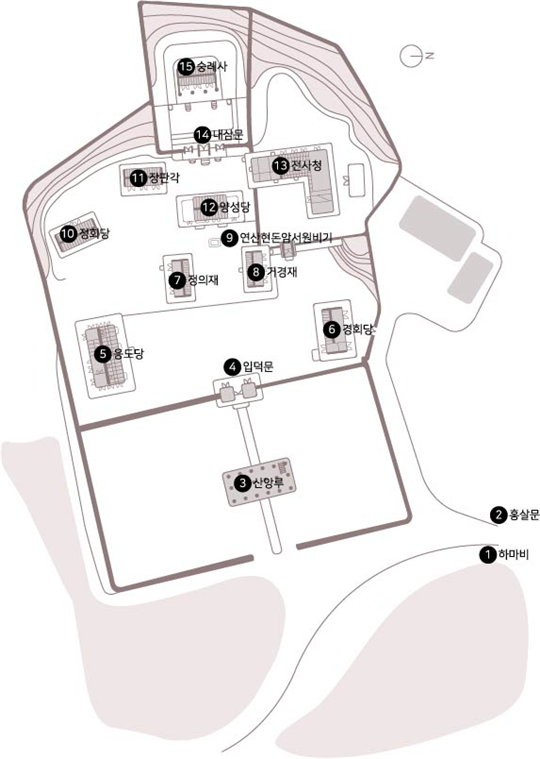논산 돈암서원
| 논산 돈암서원 Donamseowon Confucian Academy, Nonsan |
|
 논산 돈암서원, 국가문화유산포털, 문화재청. |
|
| 대표명칭 | 논산 돈암서원 |
|---|---|
| 영문명칭 | Donamseowon Confucian Academy, Nonsan |
| 한자 | 論山 遯巖書院 |
| 주소 | 충청남도 논산시 연산면 임리 74번지 |
| 지정(등록) 종목 | 사적 제383호 |
| 지정(등록)일 | 1993년 10월 18일 |
| 분류 | 유적건조물/교육문화/교육기관/서원 |
| 시대 | 조선시대 |
| 수량/면적 | 64,699㎡ |
| 웹사이트 | 논산 돈암서원, 국가문화유산포털, 문화재청. |
|
|
|
해설문
국문
논산 돈암서원은 기호학파를 대표하는 사계(沙溪) 김장생(金長生, 1548-1631)을 기리기 위해 세운 서원이다. 1634년(인조 12)에 사계를 시작으로 1658년(효종 9)에는 신독재(愼獨齋) 김집(金)集 1688년(숙종 14)에 동춘당(同春堂) 송준길(宋浚吉) 1695년(숙종 21)에 우암(尤菴) 송시열(宋時烈)의 위패를 모셨다.
돈암서원은 사계가 남긴 정신을 후학들이 받들어 기리도록 1634년에 세워졌으며 1660년 현종 원년에 사액*을 받았다. 1868년(고종 5)에 시작된 서원 정리 작업으로 1871년(고종 8)에 흥선대원군이 전국 650여 개의 서원 문을 닫으라는 훼철령을 내려 47개만 남았을 때에도 명맥을 유지하였다.
주요 건물의 배치를 보면 서원 입구에 하마비**와 홍살문***이 있고, 정면에는 2006년에 건축된 산앙루(山仰樓)가 있다. 바깥 대문인 외삼문(外三門)으로 들어서면 왼편에 유생들이 공부하는 응도당(凝道堂)이 있고, 정면에 돈암서원을 세운 사연과 김장생 부자의 업적을 적은 원정비와 양성당(養性堂)이 있다. 바깥채의 안쪽 대문인 내삼문(內三門)과 사당인 사우(祠宇)가 가장 뒤편에 배치되어 있다. 이밖에 김장생의 부친인 김계휘가 후학을 가르치던 정회당(靜會堂)과 유생들의 기숙사 거경재(居敬齋)와 정의재(精義齋), 그리고 황강실기(黃岡實記)·사계유고(沙溪遺稿)·신독재유고(愼獨齋遺稿) 등의 목판이 보존되어 있던 장판각(藏板閣)과 제사에 필요한 도구를 보관하던 전사청(典祀廳) 등이 있다.
- 임금이 이름을 지어서 편액을 내리던 일
- 말에서 내려 걸으라는 뜻으로 서원 앞에 세운 비석
- 경건한 마음으로 출입하라는 의미에서 붉은 칠을 한 문
영문
Donamseowon Confucian Academy, Nonsan
Confucian academies, called seowon in Korean, are private education institutions of the Joseon period (1392-1910) which usually combined the functions of a Confucian shrine and a lecture hall.
This Confucian academy was founded in 1634 to commemorate the scholarly achievements and virtues of Kim Jang-saeng (1548-1631), a civil official of the Joseon period. Although Kim did not take the state examination, he became a civil official through the recommendation system due to his excellence as a scholar. Kim was a highly respected authority in the study of Confucian rites. He also taught many students who went on to become widely influencial scholars.
In 1658, the spirit tablet of Kim Jip (1574-1656), Kim Jang-saeng’s son, was also enshrined here. In 1660, the academy was officially named by the king. And later, in 1688 and 1695, the spirit tablets of two of Kim Jang-saeng’s most accomplished disciples, Song Jun-gil (1606-1672) and Song Si-yeol (1607-1689), were also added to the shrine. They are two of the most renowned neo-Confucian scholars of Korea.
This Confucian academy was originally located 1.5 km to the north of the current location. However, it was frequently damaged by floods, so it was moved here in 1880. In the late 19th century, when most shrines and Confucian academies were shut down by a nationwide decree, this academy was spared demolition.
Confucian academies typically have an educational section including a lecture hall with dormitories and a ritual space including a shrine. However, this Confucian academy has two additional lecture halls. One, named Jeonghoedang, was originally established in 1557 by Kim Jang-saeng’s father, Kim Gye-hwi (1526-1582), who used it for teaching his students. The other, named Eungdodang (Treasure No. 1569), was the original main lecture hall before the academy was relocated in 1880. It had been left at the previous site until in 1975, when it was moved here.
Other buildings inside the complex include an auxiliary building for preparing rituals and a repository for storing woodblocks which were used to print Kim’s works. At the entrance to the complex are a red spiked gate and a stone marker that informs riders to dismount their horse, which both signify the entrance to a sacred place. The gate pavilion in front of main gate, called Sanangnu, was built in 2006.
Donamseowon Confucian Academy has outstanding universal value as a symbol of Korea's localization of neo-Confucianism and was a key venue for spreading neo-Confucianism to the region. It was therefore included as one of the nine Confucian Academies in Korea inscribed on the UNESCO World Heritage List in 2019.
영문 해설 내용
서원은 조선시대에 설립된 사립 교육기관으로, 선현 제향과 교육의 기능을 수행하였다.
돈암서원은 1634년 조선시대의 문신인 김장생(1548-1631)의 학문과 덕을 기리기 위해 세운 서원이다. 김장생은 과거시험을 보지 않았지만, 학문에 뛰어난 사람을 추천하는 제도를 통해 여러 관직을 지냈으며, 예학의 대가로 이름을 떨쳤다. 또한 여러 제자들을 저명한 학자로 길러내었다.
1658년에는 김장생의 아들인 김집(1574-1656)을 함께 모셨고, 1660년에 사액을 받았다. 이후 김장생의 제자인 송준길(1606-1672)과 송시열(1607-1689)의 위패를 각각 1688년과 1695년에 추가로 모셨다. 송준길과 송시열은 한국 성리학의 대표적인 학자들이다.
원래 돈암서원은 현재 위치에서 북쪽으로 약 1.5km 떨어진 곳에 있었는데, 홍수로 자주 피해를 입어 1880년 현재의 위치로 이전하였다. 19세기 말에는 서원철폐령으로 전국의 서원과 사당 대부분이 철거되었지만, 돈암서원은 철거되지 않았다.
서원은 일반적으로 강당과 동서재를 갖춘 강학영역과 사당을 갖춘 제향영역으로 구성된다. 그러나 돈암서원에는 강당이 2개 더 있다. 정회당은 김장생의 부친인 김계휘(1526-1582)가 강학하던 건물로 1557년에 세워졌다. 응도당(보물 제1569호)은 1880년 서원이 이건되기 전에 사용하던 원래의 강당이다. 1975년까지 서원의 원래 자리에 남아있다가 현재 자리로 옮겨왔다.
경내의 다른 건물로는 전사청과 김장생 부자의 문집을 간행하기 위한 목판을 보관한 장판각이 있다. 서원 입구에는 하마비와 홍살문이 있고, 문루인 산앙루는 2006년에 지은 것이다.
돈암서원은 한국 성리학의 지역적 특징을 상징하고 성리학이 전국적으로 널리 퍼지는데 중요한 역할을 하였다. 그 탁월한 보편적 가치를 인정받아 2019년 유네스코 세계문화유산에 등재된 ‘한국의 서원’ 9곳 중 하나이다.
갤러리
참고자료
- “돈암서원 UNESCO 등재 재도전기”, 놀뫼신문, 2018.08.20. https://nmn.ff.or.kr/21/?q=YToxOntzOjEyOiJrZXl3b3JkX3R5cGUiO3M6MzoiYWxsIjt9&bmode=view&idx=1127575&t=board
- “「돈암서원 응도당」보물 지정”, 문화재청, 2008.07.10. https://www.cha.go.kr/newsBbz/selectNewsBbzView.do?newsItemId=155304774§ionId=b_sec_1&mn=NS_01_02
